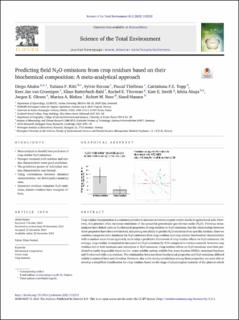| dc.description.abstract | Crop residue incorporation is a common practice to increase or restore organic matter stocks in agricultural soils. However, this practice often increases emissions of the powerful greenhouse gas nitrous oxide (N2O). Previous meta-analyses have linked various biochemical properties of crop residues to N2O emissions, but the relationships between these properties have been overlooked, hampering our ability to predict N2O emissions from specific residues. Here we combine comprehensive databases for N2O emissions from crop residues and crop residue biochemical characteristics with a random-meta-forest approach, to develop a predictive framework of crop residue effects on N2O emissions. On average, crop residue incorporation increased soil N2O emissions by 43% compared to residue removal, however crop residues led to both increases and reductions in N2O emissions. Crop residue effects on N2O emissions were best predicted by easily degradable fractions (i.e. water soluble carbon, soluble Van Soest fraction (NDS)), structural fractions and N returned with crop residues. The relationship between these biochemical properties and N2O emissions differed widely in terms of form and direction. However, due to the strong correlations among these properties, we were able to develop a simplified classification for crop residues based on the stage of physiological maturity of the plant at which the residue was generated. This maturity criteria provided the most robust and yet simple approach to categorize crop residues according to their potential to regulate N2O emissions. Immature residues (high water soluble carbon, soluble NDS and total N concentration, low relative cellulose, hemicellulose, lignin fractions, and low C:N ratio) strongly stimulated N2O emissions, whereas mature residues with opposite characteristics had marginal effects on N2O. The most important crop types belonging to the immature residue group – cover crops, grasslands and vegetables – are important for the delivery of multiple ecosystem services. Thus, these residues should be managed properly to avoid their potentially high N2O emissions. | |
